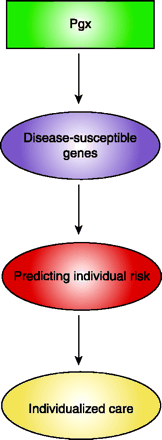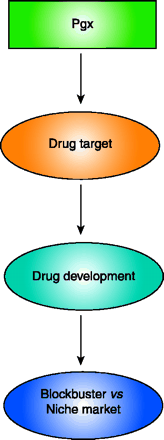Pharmacogenomics: Harbinger for the Era of Personalized Medicine?
- Wolfgang Sadée, Dr. ReR. Nat
The human genome project ushered in a period of high expectations over the applicability of sequencing data both to drug development as well as to the optimization of therapies for individual patients. Indeed, the pharmaceutical industry now exploits pharmacogenomics as an essential step in target discovery and drug development. And on the other hand, the application of genetic information to personalized medicine has begun to move us from a “one-drug-fits-all” mindset to a philosophy that dictates “the right drug for the right patient at the right dose and time.”
These two approaches are really sides of the same coin, and I use the terms pharmacogenetics and pharmacogenomics interchangeably (Pgx), recognizing that most drug effects are determined by variations in multiple genes, with genomic methodology yielding new insights beyond the single candidate gene approach. It is implicitly understood that many additional approaches are needed for successful drug discovery and personalized medicine, and the integration of all relevant information with the use of medical informatics will be the hallmark of future advances in medicine. This integrative approach, which has emerged suddenly, is best understood by considering the new field of systems biology, in which massive amounts of fragmented information are put together to simulate a physiological network, such as a cell. In this respect, a word of caution is warranted to underscore the limitations of such approaches—and of pharmacogenomics in particular. Live organisms are complex systems, the behavior of which cannot be precisely predicted. Here, I will explore the potential and limitations of pharmacogenomics and extrapolate to a few broad societal implications.


Drug Discovery and the Blockbuster Mindset
Despite hopes for a wealth of new drug targets, one conclusion to arise after completion of the human genome project was the recognition that the anticipated number of new drug targets had been grossly overestimated. In retrospect, it seems simplistic to have expected that administration of a single chemical substance, together with thousands of compounds taken in copious quantities with food, could effectively change the course of complex diseases. At the same time, a vicious circle, which is economically driven, continues to impede the launch of new drugs into clinical use and cause drug development costs to spiral out of control. The sheer size of the largest pharmaceutical companies requires treatment of large patient populations in order to attain necessary sales volumes exceeding $1 billion per year. This drives an orientation towards the one-drug-fits-all approach in an attempt to treat a majority of patients with the same symptoms (e.g., hypertension), rather than selecting subpopulations, based on disease etiology, that would reap optimal treatment responses. This broad approach has yielded valuable new drugs, but at a very high cost. Because the target population is large, regulatory agencies demand large clinical trials. The chances for failure thus increase, because unexpected adverse effects are more likely, and the risk-benefit ratio is less favorable in a mixed population. As a result, the pipeline of new blockbuster drugs needed to sustain the industry is alarmingly thin. In an attempt to overcome this deficit, massive advertising campaigns, increasingly directed towards the patient, have been launched to boost sales. Advertising costs can, in fact, exceed research budgets, which can cause disaster. For example, Vioxx sales were heavily promoted before safety studies were adequately able to gauge the risk to a rapidly growing patient population; no firm regulations had been set in place for post-marketing surveillance. The resultant costs of litigation regarding serious adverse effects could turn out to be enormous, not to speak of the fate of afflicted patients.
Hence, we are currently seeing a trend back to the use of combination therapies, in the hope of tackling disease from multiple angles, and new drugs are beginning to emerge for the treatment of numerous unmet but well-defined medical needs in smaller niche markets. Highly successful new drugs of this sort may come to enjoy wider applicability subsequent to FDA approval. In this context, pharmacogenomics may counteract the “blockbuster cycle” outlined above. Specifically, pharmacogenomics could play an increasing role in monitoring drug safety during and beyond drug development. New FDA guidelines recommend the inclusion of pharmacogenomic data with new drug applications. Although such data are not considered in the immediate drug approval process, the FDA will generate a most valuable database upon which future drug development can be streamlined. Clearly, a new direction is taking shape, whereby the pharmaceutical industry must reconcile economic and ethical imperatives with medical needs, novel pathophysiological and molecular descriptions of disease states, and the inexorable advance of personalized medicine.
Pharmacogenomics in Personalized Medicine
Therapy is already highly personalized. The entire medical history of each patient serves as a primary guide for deciding on a course of action, including choice of drug therapy and optimization of drug dosage schedules; however, much more can be done, as individualized drug therapy is still at an early stage. Lazarou et al. (1) propose that adverse drug reactions that arise despite the “appropriate” medicinal use of drugs represent the fifth leading cause of death in the US. Based on a pharmacogenetic meta-analysis of the literature covering these “unavoidable” adverse drug reactions, we have concluded that a majority of drugs prone to adverse reactions are metabolized by polymorphic enzymes, a source of interindividual variability (2). Were such an analysis used to inform therapeutic decisions, we would likely find many adverse drug reactions to be no longer “unavoidable.” With respect to efficacy, many of our best drugs, new and old, are successful in treating complex diseases at rates of only forty to seventy percent (e.g., antidepressants and antipsychotics). Failure to treat successfully a first episode of psychosis, more-over, can have life-long deleterious consequences. Similarly, treatment of coronary artery disease has made significant advances, but much more needs to be achieved. The statins, a new group of “blockbuster” drugs, inhibit cholesterol biosynthesis and are highly effective in lowering blood cholesterol in nearly all patients, but they are only about thirty percent effective in reducing risk of myocardial infarction. Given the severity and frequency of coronary artery disease, this reduction is a significant advance; however, lipid metabolism is only one of at least three primary risk factors, and lowering cholesterol alone is insufficient in some patients. The ability to predict treatment outcome for individual patients based on pharmacogenetic data would represent a significant advance and would facilitate the search for novel treatments in refractory patients.
A steadily increasing stream of research studies indicates that pharmacogenomics will be able to provide critical information for the prediction of disease and treatment outcome in clinical practice. This information will be gained only gradually, requiring years and possibly decades before coming to clinical fruition. Medical informatics, and secure but complete and immediate access to patient data as needed, will prove essential. The optimized therapy of individual patients with existing drugs has the potential to yield advances that are at least as tangible as those expected from new drugs. Still, the promise of individualized medicine is in conflict with economic incentives that remain almost exclusively focused on the patentable new chemical entity, the mainstay of the pharmaceutical industry.
Early Treatment and Prevention
Enormous resources are already devoted to our health care system. How can we provide incentives for research into efforts to optimize individual treatment? Arguably, the most promising approach is to maintain health. Effective therapy becomes increasingly difficult and expensive for complex diseases that emerge over long time periods and thus afflict mostly the elderly. Therefore, early interventions are key; in particular, behavioral changes that improve health will be most effective. Taken together with all available information on an individual, medical genetics, with a focus on disease-susceptibility genes, will allow for risk assessments based on sound scientific data. This additional information could result in earlier therapy; for example, a lower blood-pressure threshold to trigger drug therapy may be appropriate for at-risk individuals. Thus, medical genetics directly impinges on pharmacogenomics providing essential data for choice of drug therapy.
Whereas early treatment and prevention are highly promising avenues, our current health care system is poorly structured to reap full benefits. First, if we were indeed to initiate treatment ten years earlier, in the absence of overt symptoms such as hypertension or coronary artery disease, adverse effects must be exceedingly low—and so must the costs. Low-dose aspirin provides a familiar example, where the generic drug is of very low cost but quite effective. Nevertheless, there are unanswered questions, as some patients may be genetically predisposed to require much higher doses to achieve the desired antiplatelet effects. The classification of patients as good and poor responders with regard to a battery of drugs could greatly advance the sophistication with which we treat individuals, but where are the incentives to compile such detailed data? More importantly, we would have to determine which drugs are most effective in early treatment, and these may not be the same drugs necessary for effective treatment in full-blown stages of disease. Where do we garner the resources to determine whether an off-patent drug could be preferable to newer patented congeners? And is it possible that different preventive drugs are optimal for different subpopulations? Clearly, potentially large benefits remain to be reaped; how we go about providing viable economic incentives to pursue individualized care is a crucial question.
The Ideal Health Care Scenario: Focus on Data Management
Personalized medicine, including the use of (pharmaco)genetics and (pharmaco)genomics, permits increasingly accurate assessment of disease risk and prognosis. Integrated medical informatics systems will have to provide, under strict privacy rules, global access to all relevant patient data to qualified health care professionals. With more accurate predictions, health care emphasis will shift to early intervention and prevention, and full-blown drug therapy will be mobilized only when the patient manifests threshold clinical manifestations. The added value of economic incentives in such a scenario will lie increasingly in the management of medical information and the treatment of the individual patient. This economic trend will compete with the actual sale of drugs and with formulation as the driving force of pharmaceutical innovation.
Societal Consequences
With increasing life expectancy, complex diseases of old age will consume an ever increasing share of health care expenditures. As outlined above, drug costs have skyrocketed, and yet the efficacy of drug therapy declines when treating advanced chronic diseases. While excellent advances have been made, we must recognize the limits of drug therapy. Arguably, a main cause of population morbidity is rooted in behavior and life style, including factors such as smoking, poor diet, lack of exercise, and lack of active mental engagement. Even the most sophisticatedly planned treatment, exploiting novel drugs and optimizing existing therapies, can be doomed if the individual’s behavior is counterproductive; therefore, resources must also focus on behavioral interventions. As the number of “druggable” genes is finite, leading to phenomena already seen in today’s pharmaceutical industry (e.g., thinning pipelines), we may find that other types of therapy will gain in importance (e.g., stem cells, gene therapy, and “intelligent” nanodevices). Much is at stake, not the least of which is the direction the pharmaceutical industry will take, and we must make sure that future care remains affordable to all. The economic and political systems that underlie our advances, moreover, must continue to provide incentives for innovation.
What must be done?
-
Find ways to control the spiraling costs of new drug development. Focusing on targeted patient populations where drug efficacy will be optimal could help achieve this goal. Pharmacogenomics could become a routine part of this process.
-
Enhance postmarketing surveillance of drugs to identify poor responders and adverse drug effects. Regulatory guidelines that provide incentives for determining the causes underlying variable drug response will enhance our ability to predict treatment outcome a priori.
-
Provide resources for large-scale studies of early drug treatment, regardless of patent status of the test drug; provide resources for behavioral interventions.
-
Generate economic incentives reflecting the value of each step of novel health care strategies, rather than focusing on profits from the sale of patented drugs as the main driving force in the pharmaceutical industry. Provide a long-term roadmap to permit dynamic adjustments with emerging trends and to maintain a viable industry.
-
Acknowledge that our current health care system is under stress, necessitating a set of long-term guidelines based on principles of medical science, ethics, economics, law, and social sciences, capable of balancing our collective health care need with a sustainable health care system.
- © American Society for Pharmacology and Experimental Theraputics 2005

Wolfgang Sadée, Dr. rer. Nat., is Felts Mercer Professor of Medicine and Pharmacology at The Ohio State University College of Medicine. E-mail Sadee-1{at}medctr.osu.edu.



